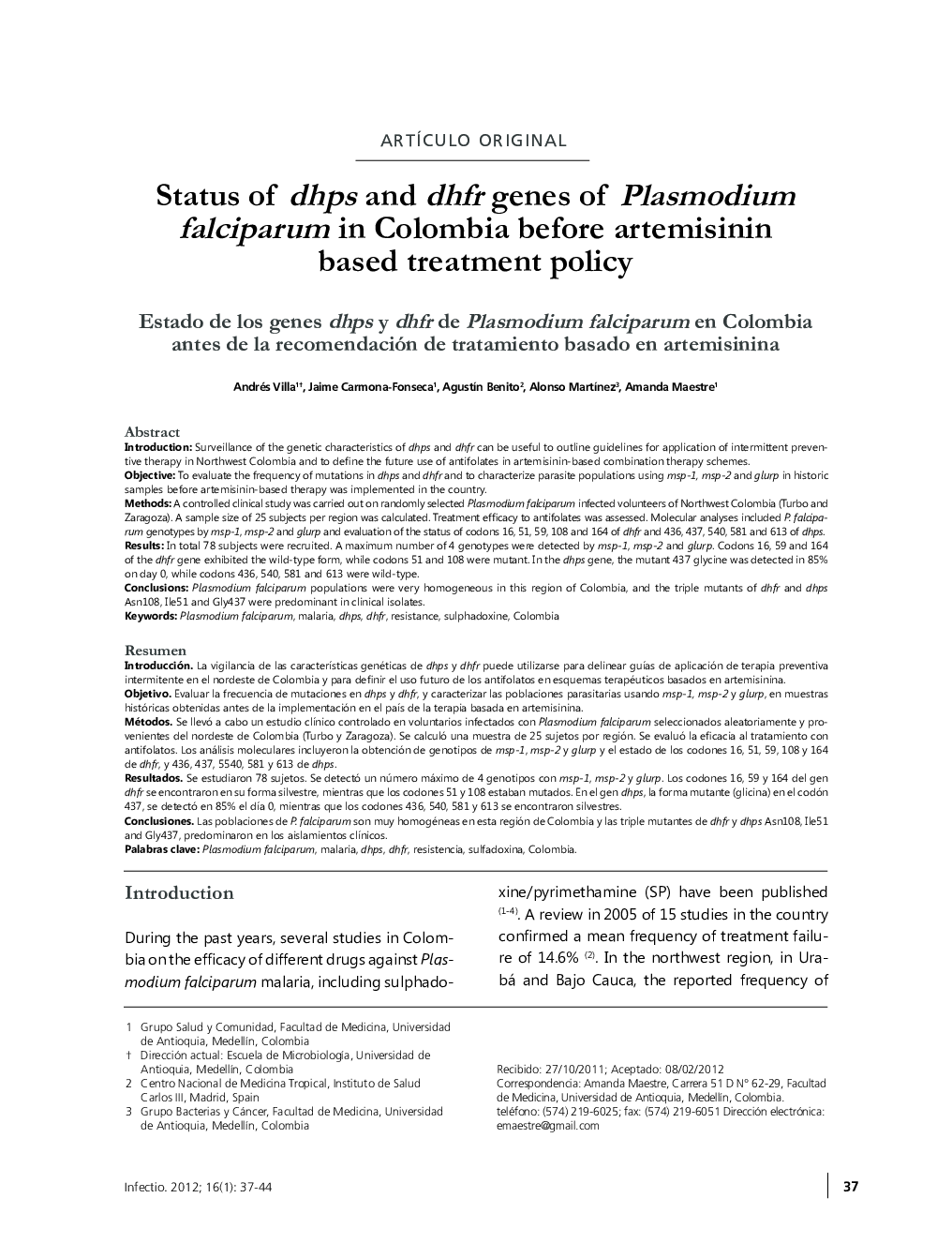| Article ID | Journal | Published Year | Pages | File Type |
|---|---|---|---|---|
| 3403745 | Infectio | 2012 | 8 Pages |
IntroductionSurveillance of the genetic characteristics of dhps and dhfr can be useful to outline guidelines for application of intermittent preventive therapy in Northwest Colombia and to define the future use of antifolates in artemisinin-based combination therapy schemes.ObjectiveTo evaluate the frequency of mutations in dhps and dhfr and to characterize parasite populations using msp-1, msp-2 and glurp in historic samples before artemisinin-based therapy was implemented in the country.MethodsA controlled clinical study was carried out on randomly selected Plasmodium falciparum infected volunteers of Northwest Colombia (Turbo and Zaragoza). A sample size of 25 subjects per region was calculated. Treatment efficacy to antifolates was assessed. Molecular analyses included P. falciparum genotypes by msp-1, msp-2 and glurp and evaluation of the status of codons 16, 51, 59, 108 and 164 of dhfr and 436, 437, 540, 581 and 613 of dhps.ResultsIn total 78 subjects were recruited. A maximum number of 4 genotypes were detected by msp-1, msp-2 and glurp. Codons 16, 59 and 164 of the dhfr gene exhibited the wild-type form, while codons 51 and 108 were mutant. In the dhps gene, the mutant 437 glycine was detected in 85% on day 0, while codons 436, 540, 581 and 613 were wild-type.ConclusionsPlasmodium falciparum populations were very homogeneous in this region of Colombia, and the triple mutants of dhfr and dhps Asn108, Ile51 and Gly437 were predominant in clinical isolates.
ResumenIntroducciónLa vigilancia de las características genéticas de dhps y dhfr puede utilizarse para delinear guías de aplicación de terapia preventiva intermitente en el nordeste de Colombia y para definir el uso futuro de los antifolatos en esquemas terapéuticos basados en artemisinina.ObjetivoEvaluar la frecuencia de mutaciones en dhps y dhfr, y caracterizar las poblaciones parasitarias usando msp-1, msp-2 y glurp, en muestras históricas obtenidas antes de la implementación en el país de la terapia basada en artemisinina.MétodosSe llevó a cabo un estudio clínico controlado en voluntarios infectados con Plasmodium falciparum seleccionados aleatoriamente y provenientes del nordeste de Colombia (Turbo y Zaragoza). Se calculó una muestra de 25 sujetos por región. Se evaluó la eficacia al tratamiento con antifolatos. Los análisis moleculares incluyeron la obtención de genotipos de msp-1, msp-2 y glurp y el estado de los codones 16, 51, 59, 108 y 164 de dhfr, y 436, 437, 5540, 581 y 613 de dhps.ResultadosSe estudiaron 78 sujetos. Se detectó un número máximo de 4 genotipos con msp-1, msp-2 y glurp. Los codones 16, 59 y 164 del gen dhfr se encontraron en su forma silvestre, mientras que los codones 51 y 108 estaban mutados. En el gen dhps, la forma mutante (glicina) en el codón 437, se detectó en 85% el día 0, mientras que los codones 436, 540, 581 y 613 se encontraron silvestres.ConclusionesLas poblaciones de P. falciparum son muy homogéneas en esta región de Colombia y las triple mutantes de dhfr y dhps Asn108, Ile51 and Gly437, predominaron en los aislamientos clínicos.
